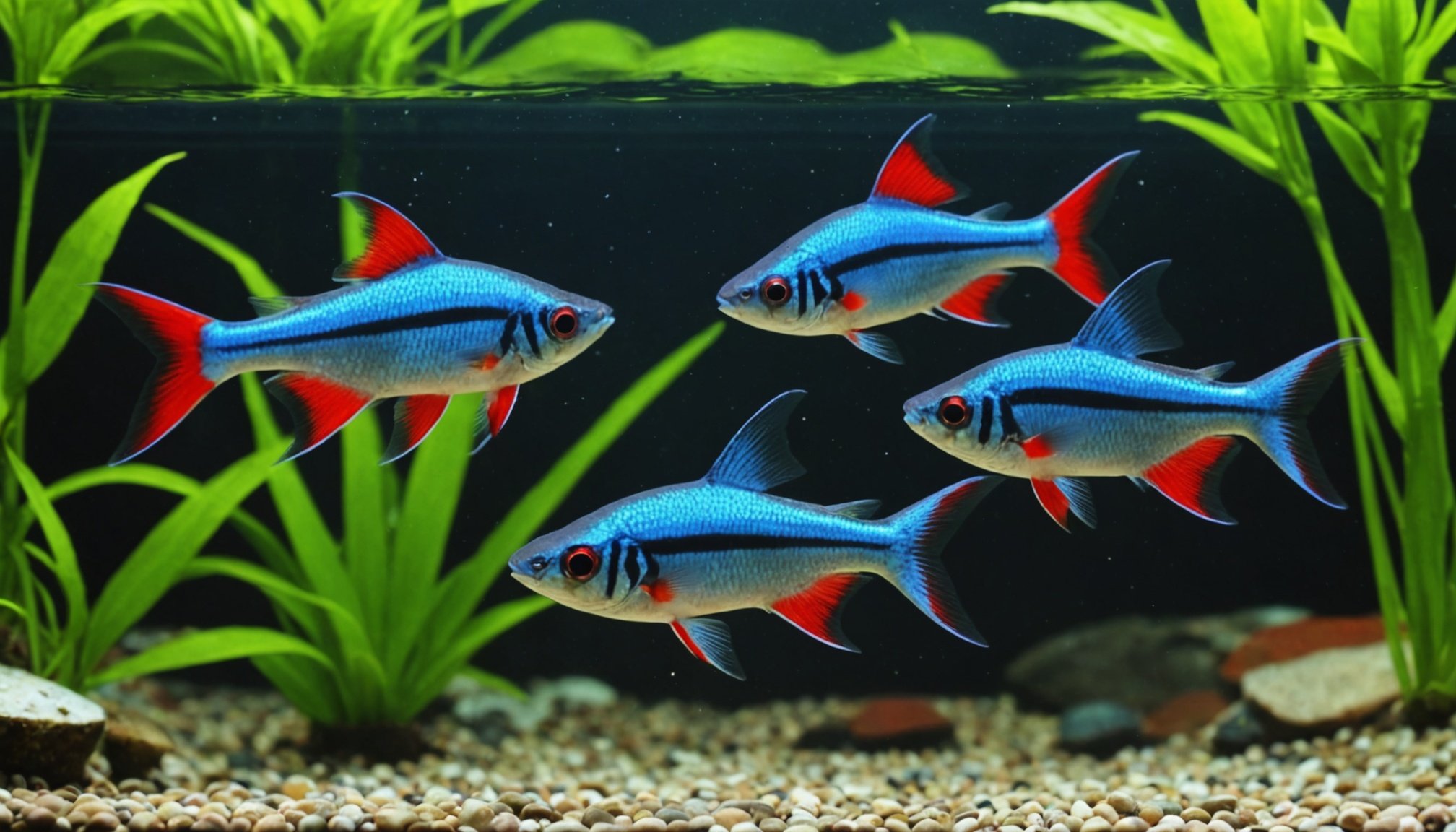Unlocking Optimal Water Conditions: Essential Parameters for Successfully Breeding Neon Tetras in Your Home Aquarium
Breeding neon tetras can be a rewarding and fascinating hobby, but it requires a deep understanding of the specific water conditions these delicate fish need to thrive. In this article, we will delve into the essential parameters and practices necessary for creating an ideal breeding environment for your neon tetras.
Understanding the Natural Habitat of Neon Tetras
To successfully breed neon tetras, it’s crucial to replicate their natural habitat as closely as possible. Neon tetras are native to the freshwaters of South America, specifically in the blackwater streams and rivers of the Amazon basin. These environments are characterized by soft, slightly acidic water with low hardness and high oxygen levels.
Also read : Creating the perfect indoor retreat for your pet rabbit: must-have tips for a cozy british winter
Water Parameters in the Wild
- pH Levels: In their natural habitat, neon tetras are accustomed to a pH range of 6.0 to 7.0, with a slight acidity being more favorable[5].
- Water Hardness: The water hardness is typically very low, ranging from 1 to 4 degrees of general hardness (dGH)[5].
- Water Temperature: The temperature in these streams and rivers usually ranges from 22°C to 27°C (72°F to 81°F)[1].
Replicating the Natural Habitat in Your Aquarium
To breed neon tetras successfully, you need to replicate these conditions in your aquarium.
Setting Up the Breeding Tank
When setting up a breeding tank for neon tetras, several key factors must be considered:
Also to read : Unlocking the secrets of rat training: expert methods to teach your pet rat fun tricks
- Tank Size: A 10-gallon tank is often recommended for breeding neon tetras. This size provides enough space for the fish to swim and for the necessary water volume to maintain stable conditions[5].
- Water Temperature: Maintain a temperature range of 22°C to 27°C (72°F to 81°F). Consistency is key, so ensure your tank has a reliable heating system.
- Water pH and Hardness: Use a pH test kit to ensure the pH is between 6.0 and 7.0. For water hardness, aim for a level of 4° dGH or less. You can use water softeners or RO (reverse osmosis) water to achieve these parameters[5].
Aquatic Plants and Hiding Spots
Aquatic plants are essential for creating a natural environment. Here are some reasons why:
- Oxygenation: Live plants help oxygenate the water, which is crucial for neon tetras.
- Hiding Spots: Plants provide hiding spots and reduce stress, which is vital for breeding.
- Water Quality: Plants absorb excess nutrients and help maintain stable water conditions.
Some recommended plants for a neon tetra breeding tank include Java moss, Anacharis, and Amazon swordplants.
Essential Water Parameters for Breeding Neon Tetras
Here is a detailed list of the essential water parameters you need to monitor and maintain:
Key Water Parameters
- pH: 6.0 to 7.0
- Slightly acidic water is preferred for breeding.
- Water Hardness: 1 to 4° dGH
- Soft water is crucial for neon tetras.
- Water Temperature: 22°C to 27°C (72°F to 81°F)
- Consistent temperature is vital.
- Water Flow: Gentle flow
- Avoid strong currents that can stress the fish.
- Oxygen Levels: High oxygen levels
- Ensure good water circulation and the presence of live plants.
Water Quality Maintenance
Regular water changes and monitoring are essential to maintain optimal water quality.
- Weekly Water Changes: Perform 10-20% water changes weekly to keep the water fresh and stable.
- Water Tests: Regularly test the water for pH, ammonia, nitrite, and nitrate levels to ensure the environment remains healthy for your fish.
Diet and Nutrition for Breeding Neon Tetras
Neon tetras are omnivorous, meaning they eat a variety of foods including small insects, plankton, and algae.
Food Recommendations
- Commercial Foods: Use high-quality commercial foods such as pellets, granules, or flakes as the staple diet.
- Live and Frozen Foods: Supplement with live, frozen, or freeze-dried foods like brine shrimp, bloodworms, and daphnia.
- Variety: Ensure a varied diet to provide all the necessary nutrients for healthy breeding.
Tank Mates and Community Considerations
When breeding neon tetras, it’s important to choose tank mates that are compatible and non-aggressive.
Compatible Tank Mates
- Small Peaceful Fish: Species like harlequin rasboras, lemon tetras, and dwarf gouramis can coexist peacefully with neon tetras.
- Shrimp: Some species of shrimp, like neocaridina, can be good tank mates as they are non-aggressive and help with algae control[4].
Avoiding Aggressive Fish
Avoid keeping aggressive or large fish in the same tank as neon tetras, as they can cause stress and reduce breeding success.
Practical Tips for Successful Breeding
Here are some practical tips to increase your chances of successfully breeding neon tetras:
Creating a Stress-Free Environment
- Avoid Overcrowding: Keep the tank lightly stocked to reduce stress on the fish.
- Provide Hiding Spots: Ensure there are plenty of plants and decorations for the fish to hide and feel secure.
- Maintain Consistency: Keep water parameters consistent and avoid sudden changes.
Monitoring and Maintenance
- Regular Observations: Regularly observe your fish for signs of stress or illness.
- Clean Equipment: Ensure all equipment, including filters and heaters, is clean and functioning properly.
Breeding Process and Challenges
Breeding neon tetras involves several steps and can come with its own set of challenges.
Spawning Process
- Sexing the Fish: Identify male and female neon tetras. Males are typically smaller and have a more slender body than females.
- Spawning Conditions: Ensure the water conditions are optimal for spawning, with slightly acidic and soft water.
- Separating the Fry: After spawning, separate the eggs from the adults to prevent them from being eaten.
Common Challenges
- Water Conditions: Failing to maintain the correct water conditions is a common reason for breeding failure.
- Disease: Neon tetras are susceptible to diseases like neon tetra disease, which can be devastating to a breeding program.
- Predation: Ensure that the tank is free from predators that could eat the eggs or fry.
Breeding neon tetras is a challenging but rewarding experience that requires careful attention to detail and a deep understanding of their natural habitat. By replicating the optimal water conditions, providing a balanced diet, and maintaining a stress-free environment, you can increase your chances of successfully breeding these beautiful fish.
Summary Table: Optimal Water Parameters for Breeding Neon Tetras
| Parameter | Optimal Range |
|---|---|
| pH | 6.0 to 7.0 |
| Water Hardness | 1 to 4° dGH |
| Water Temperature | 22°C to 27°C (72°F to 81°F) |
| Water Flow | Gentle flow |
| Oxygen Levels | High |
| Water Changes | 10-20% weekly |
By following these guidelines and maintaining a consistent and healthy environment, you can unlock the secrets to successfully breeding neon tetras in your home aquarium. Remember, patience and attention to detail are key to achieving success in this rewarding hobby.











